
Pleopeltis polypodioides, also known as the resurrection fern, is a species of creeping, coarse-textured fern native to the Americas and Africa.
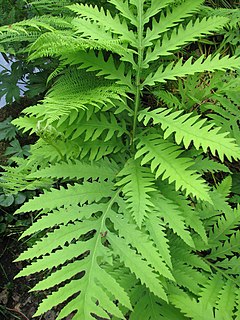
Onoclea sensibilis, the sensitive fern, also known as the bead fern, is a coarse-textured, medium to large-sized deciduous perennial fern. The name comes from its sensitivity to frost, the fronds dying quickly when first touched by it. It is sometimes treated as the only species in Onoclea, but some authors do not consider the genus monotypic.

Athyrium filix-femina, the lady fern or common lady-fern, is a large, feathery species of fern native throughout most of the temperate Northern Hemisphere as well as Central and South America. It is often abundant in damp, shady woodland environments and is often grown for decoration.
Alsophila acrostichoides, synonym Cyathea acrostichoides, is a species of tree fern native to the Maluku Islands and Western New Guinea, where it grows in forest and disturbed sites at an altitude of 650–1100 m. The trunk is erect and usually 1–3 m tall. Fronds are bipinnate and 1–2 m long. The stipe is slender and covered with spines. It is sparsely covered with medium brown scales. Sori cover most of the underside of fertile pinnules. A. acrostichoides lacks indusia.
Alsophila cuspidata, synonym Cyathea cuspidata, is a widespread species of tree fern native to Central and South America, where it grows in tropical rain forest up to the montane zone, as well as in open sites, on riverbanks and cleared pastureland at an altitude of 0–800 m. Its natural distribution covers Mexico, Guatemala, Belize, Honduras, El Salvador, Nicaragua, Costa Rica, Panama, Colombia, Ecuador, Peru, Bolivia, Paraguay, the Amazon Basin, Brazil and French Guiana. This species often has multiple trunks, which may be 15 m tall and about 10 cm in diameter. They are covered in black spines and together form a medium-sized, feathery clump. Fronds are bipinnate and 2–3 m long. The rachis and stipe are brown to dark brown and are covered with scales. The scales are bicoloured, having a dark brown to blackish centre and a pale, whitish margin. Pinnule veins sometimes have small, brown, star-shaped scales. Sori are round and form on either side of the pinnule midvein. They are covered by globose indusia.
Alsophila gregaria, synonym Cyathea gregaria, is a species of tree fern endemic to eastern New Guinea, where it grows in lowland forest and coastal rain forest, often forming clumps, at an elevation of up to 100 m. The trunk of this plant is erect and usually 4–5 m tall and about 10 cm in diameter. Fronds may be bi- or tripinnate and 2–3 m in length. The stipe bears spines, but has few scales. These scales are medium brown in colouration and have a paler margin. Sori occur near the fertile pinnule midvein and lack indusia.

Polystichum acrostichoides, commonly denominated Christmas fern, is a perennial, evergreen fern native to eastern North America, from Nova Scotia west to Minnesota and south to Florida and eastern Texas. It is one of the most common ferns in eastern North America, being found in moist and shady habitats in woodlands, stream banks and rocky slopes. The common name derives from the evergreen fronds, which are often still green at Christmas.

Amauropelta noveboracensis, the New York fern, is a perennial species of fern found throughout the eastern United States and Canada, from Louisiana to Newfoundland, but most concentrated within Appalachia and the Atlantic Northeast. New York ferns often forms spreading colonies within the forests they inhabit.
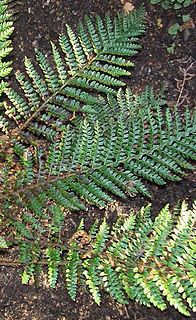
Polystichum proliferum, commonly known as mother shield fern is an Australian endemic fern. The genus name Polystichum is derived from Greek poly - many, and stichos - rows referring to the many rows of sori. The species name is derived from Latin, Proli – offspring and fer - bearing referring to the proliferous buds, a prominent feature of the species.
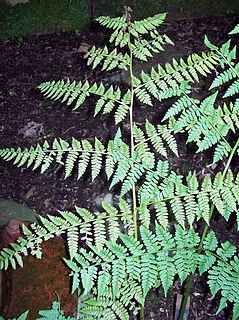
Diplazium australe, commonly known as the Austral lady fern, is a small fern occurring in eastern Australia, New Zealand and Norfolk Island. The habitat is moist shaded areas, often occurring in rainforest.
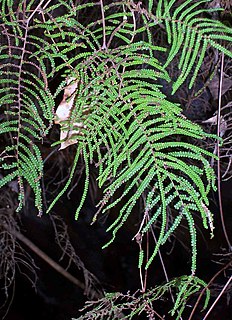
Gleichenia dicarpa, commonly known as pouched coral fern or tangle fern, is a small fern of the family Gleicheniaceae found in eastern Australia, New Caledonia and New Zealand. It forms tangled thickets in wet places such as swamps and riverbanks.

Histiopteris incisa, the bat's wing fern, water fern or fern mata, is a common plant found in Australia, New Zealand and other islands in the south Pacific region. Usually found in moist areas, where it may form large colonies. The lowermost lobes of each pinnae have a bat wing like appearance, giving the fern its common name.
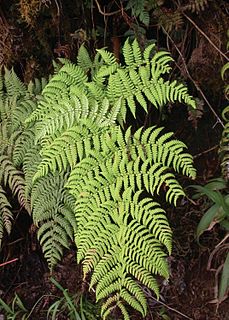
Dryopteris macropholis is a species of fern. It is distributed on the Marquesas Islands.

Asplenium tutwilerae is a rare epipetric fern found only in Hale County, Alabama, United States. A. tutwilerae is a fertile allotetraploid, formed by the chromosomal doubling of a specimen of the sterile diploid A. × ebenoides, a hybrid of A. platyneuron and A. rhizophyllum. Except for its spores, which are fertile rather than malformed, A. tutwilerae is essentially identical to A. × ebenoides and was described as part of that species until 2007. It is named in honor of Julia Tutwiler, who discovered the only known wild population at Havana Glen in 1873.

Dryopteris inaequalis is an Afrotropical fern species that ranges from tropical and southern Africa to Madagascar. It has been recorded in Tanzania, Zambia, Malawi, Mozambique, Zimbabwe and South Africa, where it is present in the Western Cape, Eastern Cape and KwaZulu-Natal. It is found on forest floors and along forest margins, from middle to high altitudes.

Cadaba aphylla ("Swartstorm") is one of some 30 species in the genus Cadaba. It is indigenous to southern Africa.

Gleichenia abscida, commonly known as dwarf coral fern, is an uncommon alpine fern found in southwestern Tasmania. Described by English born dentist and botanist Leonard Rodway, that which distinguishes G. abscida the most from all other species of Gleichenia is its frond. While each other species of Gleichenia have a repetitively branching frond, G. abscida's frond consists of just two blades, with the apical axil between these two blades lacking meristematic tissue.
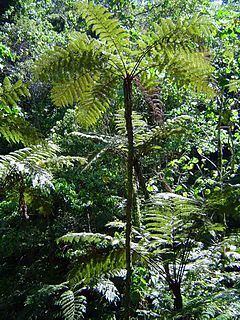
Alsophila manniana, synonym Cyathea manniana, the spiny tree fern or sheshino, is a species of tree fern. It is readily identified by the fierce spines on its trunk, and is widespread in the tropical regions of Africa.

Hymenophyllum rarum, the narrow filmy-fern, is a species of fern from the family Hymenophyllaceae. This thin-leaved fern is commonly found in New Zealand and Tasmania, growing in patches on rocks and is epiphytic on trees and tree ferns, growing in moist gullies or rainforests. A rather drought tolerant species often found at exposed sites ranging from coastal to montane areas. Forming extensive, interwoven and creeping patches with its thin long (creeping) rhizomes sparsely covered in red-brown hairs, easily recognised by its membranous grey-green fronds, the smooth margins of the pinnae, ultimate segments and indusia; and by the sunken sori in the uppermost segments of the uppermost pinnae. The species can be found throughout Tasmanian rainforests as well as occurring in New South Wales, Victoria and New Zealand on the North and South Islands as well as, Stewart, Chatham and Auckland Islands.

Sticherus tener, also known as silky fan-fern, is a common native ground-fern in the family Gleicheniaceae. It occurs growing along watercourses and drainage lines in rainforest that are dominated by Nothofagus cunninghamii. In Australia, it occurs in the states of Tasmania and Victoria. In New Zealand, it is known from two disjoint regions on the South Island. Like in other members of this genus, Sticherus tener have bright green fronds with repeatedly forking branches, branches bearing linear-shaped segments at almost right angles to the axis and form umbrella-like bush colony.



















